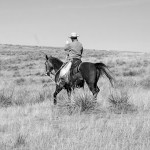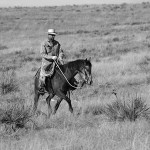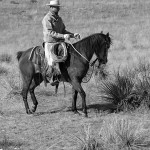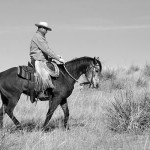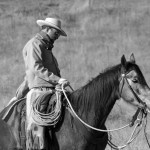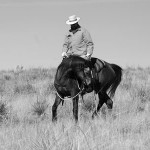Ty Weber of Kiowa, Colo., takes us along with him on such a ride, on a young mare with lots of energy, on a day with lots of distractions, to show us how we as riders can use natural obstacles to help our horses mentally and physically.
“When I first moved here I saw all this yucca and thought I had a big job ahead of me, clearing it out of the pastures,” says Ty. “Then I started riding colts like this one and older horses that had some issues and started realizing how handy this stuff is, because they will not go through it, and you can use that to accomplish so many things on a ride.
“This mare has about 12 rides on her, and she has a lot of energy. Riding her in the arena is not going to help work through some of the issues that she has, and neither is just riding for miles and miles at a time. What I’m going to be working on with her really is getting her ready to do a job, and to do that I need her to be feeling of me, and following my feel in what I ask her to do. This isn’t about making her tired, it’s about getting a change in her mind. If I can get a little change today, I can build on that with another change tomorrow.”
The following photos come from a ride on one specific horse on one day; but you can take the ideas from this ride and apply them to your own horses where they are fitting. If you don’t have yucca where you ride, you might have sagebrush, or rocks or some other natural obstacle that you can use in a similar fashion. If your only option is to ride in an arena or pen, you can create obstacles to work in a similar way.

Getting To The Feet
1. So I’ll start using a little of this energy by giving her jobs to do going around this big yucca. I’m not going to hold her here, I’ll just direct, first by looking where I want to go, then following up with my legs and reins. She’s wanting to walk faster than I would like, so I’ll just keep a slow walk rhythm in my seat and wait for her to follow it.

2. When she slows her rhythm to match mine I’ll let her come off the yucca. I make sure that the release is away from the barn, so she starts to think about looking to leave her buddies being a good thing.
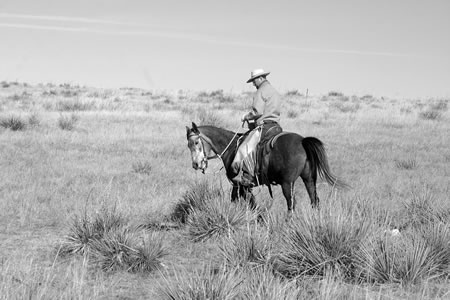
3. If she speeds up, she can go back to work around the yucca. She will learn that her decision is what creates the release, I’m not going to make the decision for her. I wouldn’t move on to work on anything else until I feel her start to follow my feel as I direct her around these yucca. I won’t have anything to build on without that feel. So I’ll just keep working through the yucca patch making lots of changes of direction.

Turns on the Hindquarters
4. Now that I’ve got a little bit of a feel started with her feet, I’m going to start asking for specific things from her feet. Here I’ll ride toward a yucca and ask for her front quarters to step across.

5. I’ll look to the left and twist my body in the direction I want her to go.

6. Her left front reached out and over and …

7. … her right front steps across. That was a pretty nice turn for such a green horse, and it was all without pulling or spurring. I can use her energy and the yucca and get some nice turns started. She does not want to step into the yucca, so she is going to get her body arranged, get her weight back onto her hindquarters so that she can move her feet and not step into the yucca.

Turns on the Front Quarters
8. If at any point she offers to stop and stand, I’m going to let her. She was so busy to start, that is a big change for her to want to stand. I’ll rub on her and let her enjoy that. Here she’s even looking back toward the barn, and usually she’d try and head back, but she’s standing here quietly. That’s a nice little change.
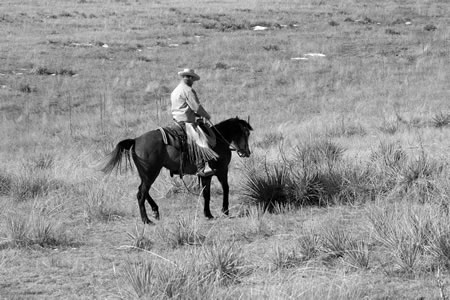
9. When she wants to go again, I say sure, let’s go back to work. Now I’ll try some turns on the forehand. The yucca keep her from walking forward, and I use my leg to ask her to step over behind. I’ll start with my left leg.
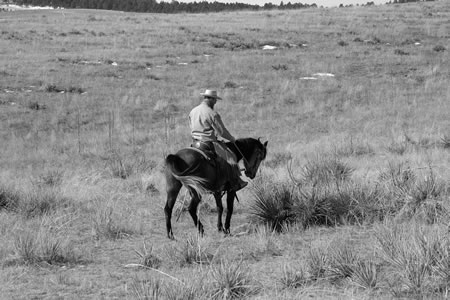
10. Since we just did all that work on turning on the hindquarters I want to make a clear change in my weight, have it a little more forward, so it’s clear to her I want something different.

11. Then I’ll ask her to step her hindquarters off my right leg, over to the left. The most important thing is to not lose your patience or your focus. It might seem like you have to be really busy, but I know that in the end it will pay off; I’ll be busy on this ride so that some day I won’t have to be busy.
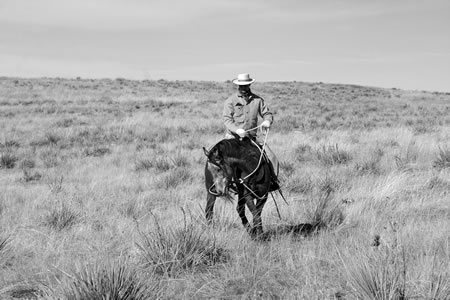
Drifting the Shoulder
12. Another good exercise that I like to do here is to ride straight at a yucca and pick up her shoulder and drift it away to go around it. So if I ride toward one of these yucca she has to move her feet, she has to make a choice. I’ll give it a try.

13. Here, it’s effective, but not as soft as I’d like it to be. If she misses one I don’t worry about it, because it’s just that I didn’t prepare her properly. Next time I’ll try and prepare her better.

14. Here, I pick her up and drift her to the right.

15. You can really see here how she is drifting away with that left shoulder. I make sure her feet are nice and slow. I wouldn’t release after drifting her if her feet were speeding up. Again, this is a way that I can take advantage of all the liveliness she has, I look at it as a good thing. She is giving me lots of opportunities to help her get soft and responsive.

Picking Up The Reins
16. Now I just might add a little feel here with both reins to start a little bit of collection as I work around the yucca. I’ll give a little squeeze with my legs and ask for some lateral and vertical flexion at the same time. She might think that my leg is asking her to speed up, and so these obstacles can help her keep her feet slow without me pulling on her.

17. My legs tell her feet where to be; one leg at a time asks her to move laterally, both legs together tell her to get her hind feet up underneath her. I’m wrapping my legs around her and asking her to pick up her back. Having her hind feet underneath her prepares her for doing a job. It could be any job; a stop, working a cow, changing direction, or a transition. I’m just asking her to be in a more athletic position so she can be prepared for anything that I might ask of her.

Stopping and Backing
18. As I work through these different exercises I’ll also work on letting the yucca stop her. She can learn to stop from a feel from my body and not by me pulling her to a stop. I’ll ride toward a yucca and take all the life out of my body. When she stops I’ll make a big deal of it, and let her stay as long as she will keep her feet still. I’d like her to relax a little more, let her head drop and not feel so ready to leave, but if I can get a little change today, I know it will be better on our next ride.

19. Similarly, she might offer to back while I’m working on these various exercises, thinking that that is what I’m looking for. I won’t stop her, because I like that she’s offering something that I will need later, but for now I don’t want to do too much backing out here because I wouldn’t want to back her into a yucca and betray her. If you back them up into something that is in their blind spot that can hurt them, it won’t help their confidence in what you’re asking them to do. So I’m really not going to do a whole lot of backing out here with her, until she gets a little further along and I have more control, Then I’ll back her through here quite a bit, for the same reason. If she doesn’t follow my leg and my feel, she will run into something. But she’s not to that point yet.

Doubling
20. Now I’ve reached a point in this ride where I’ve got a good feel down to her feet, and she’ll stop and wait for a short amount of time, but not as long as I’d like her to wait before I step off. So I might have to make things a little more black and white so she’s more certain about staying stopped. I’ll put a little pressure on her here, and ask her to really move those feet. She might swish her tail and get bothered before it’s clear to her.

21. You don’t get a horse’s feet still by holding them, you get them still by asking them to move and then letting her stop. So what I’m doing is saying “Yes” to what she is offering; she wants to move, so I say yes, let’s move.

22. I’ll be sure and double her on the same side that she started to go. If I had started out trying this it wouldn’t have worked, because I didn’t have enough feel started down to her feet, and she had too much energy. But now, this can be an effective way of showing her really clearly what I want.

23. It might take giving her a lot of what she thought she wanted (moving her feet) to find that she’d really rather stand still. There she took a big deep breath, that’s a huge change. Her head dropped a little bit and her feet feel more settled, and she acts like she really wants to stay.

Checking It Out
24. Now that she seems like she wants to stay, I might just test it out by adding a little more life and see if she can keep her feet still. There is no way she’d be useful to me to rope off of unless she can stand still. I’d like her demeanor to be a little more relaxed, but for this mare, this is a big change.

25. She is standing quiet on a slack rein, and she took some weight off a hind foot which is a pretty good indication she’s going to stay. Her expression tells me she’s not 100% convinced this is a good deal, but she’s hanging in there. I’d better quit before I ruin it!

Finishing Up
26. I’ll step off of her on the uphill side, just to be safe.
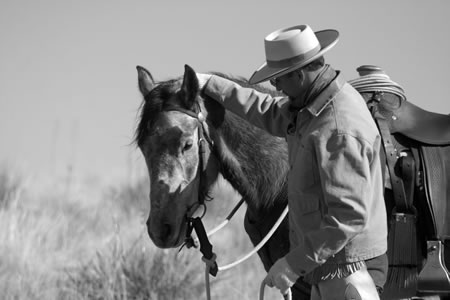
27. I’ll loosen the cinch and rub on her. I want her to feel really good about the end of the ride, and be thinking about this the next time we ride out; that the end of the ride isn’t when she gets back to her buddies, that the end of the ride is somewhere out here ahead of her so she can start hunting that release and not always looking back to her buddies. If the ground wasn’t slick like it was today, you could do all these same exercises at a trot, but you can get quite a little bit done with a horse at a walk like this and make a big change in her by getting to her feet and her mind. It might be easy to get frustrated with a lively horse like this, but I try and look at it as a positive, and think about how much I can get done with all that life.





